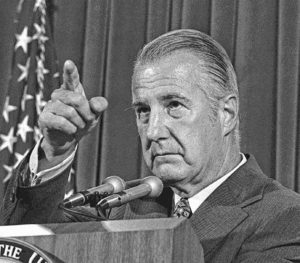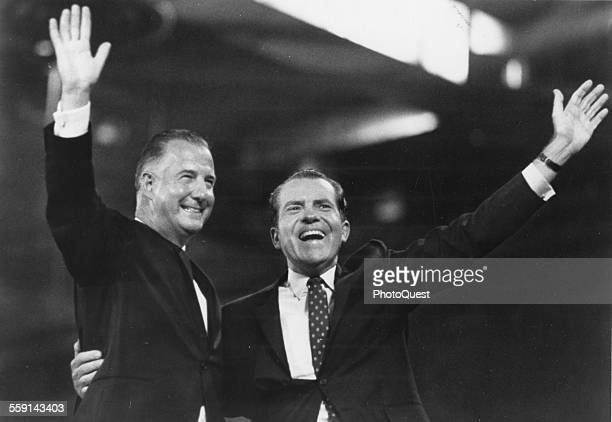Richard Nixon’s vice president Spiro Agnew resigned in 1973 after it was revealed he had taken bribes and committed tax fraud. Agnew’s ghost still haunts American politics today. In this blog post, we will explore the life and legacy of Spiro Agnew. From his biography and rise to power, to the scandal that brought him down, to his resignation and current place in history, read on to learn more about this fascinating figure.
Who was Spiro Agnew?
Spiro Agnew was an American politician who served as the 39th vice president of the United States from 1969 until his resignation in 1973. A member of the Republican Party, Agnew served as the county executive of Baltimore County, Maryland before being elected to the House of Representatives in 1966. He was then elected to the Senate in 1968 and became vice president after Richard Nixon won the presidential election that year.
As vice president, Agnew was a vocal critic of the anti-war protesters and hippies who he saw as a threat to America’s values. He also clashed with the press, calling them “nattering nabobs of negativism.” In 1973, it was revealed that Agnew had accepted bribes while he was governor of Maryland and he resigned as vice president rather than face impeachment. After leaving office, Agnew disappeared from public life and died in 1996.
Agnew’s rise to vice president
As Vice President, Spiro Agnew was second in line for the presidency. In 1968, he was elected on a ticket with Nixon, and he served as Vice President from 1969-73.
Agnew was born in 1918 in Baltimore, Maryland. He graduated from Johns Hopkins University and then from the University of Baltimore School of Law. He served in the U.S. Army during World War II. After the war, he returned to Baltimore and practiced law.
In 1957, Agnew was appointed as County Executive of Baltimore County. He was elected Governor of Maryland in 1966. As Governor, he increased state spending on education and highways, and he opposed racial segregation.
In 1968, Agnew was nominated for Vice President at the Republican National Convention. He ran on a ticket with Nixon, and they were elected in November 1968. As Vice President, Agnew was responsible for overseeing the administration’s domestic policies.
However, Agnew’s time as Vice President was not without scandal. In 1973, he was accused of taking kickbacks from contractors while he was Governor of Maryland. He resigned as Vice President in October 1973 and pleaded no contest to tax evasion charges.
The scandal that led to Agnew’s resignation
In 1973, Vice President Spiro Agnew was accused of accepting bribes while he was governor of Maryland. He pleaded no contest to the charges and resigned from office. The scandal led to a constitutional crisis, as it was unclear whether President Nixon would be able to appoint a new vice president. Ultimately, Nixon chose Gerald Ford as his new vice president.

What happened to Agnew after he resigned?
Agnew’s resignation came as a result of an investigation into his tax returns. The investigation revealed that Agnew had accepted bribes and kickbacks totaling more than $100,000 while he was governor of Maryland.
After resigning, Agnew pleaded no contest to a single count of tax evasion and was fined $10,000. He was also disbarred from practicing law in Maryland.
Agnew largely faded from the public eye after resigning from office. In 1996, he published an autobiography entitled Go Quietly… Or Else. In it, Agnew claimed that Nixon had ordered him to resign so that the president could appoint a new vice president who would be more loyal to Nixon.
Agnew died in 1996 at the age of 77.
Spiro Agnew’s life before politics
Before Spiro Agnew became the Vice President of the United States, he had a long and varied career. He was born in Baltimore, Maryland in 1918 and raised in a middle-class family. After graduating from high school, he attended Johns Hopkins University. He then transferred to Princeton University, where he studied chemistry.
Agnew enlisted in the Army during World War II and served stateside as an Aberdeen Proving Ground chemical warfare specialist. After the war, he returned to Johns Hopkins University and earned his law degree from there in 1947.
Agnew began his law career working for a prestigious Baltimore firm. In 1957, he left that firm to become legal counsel for the Maryland Committee on Interstate Cooperation. This committee was responsible for studying problems related to interstate commerce and making recommendations to the legislature on how to deal with them.
In 1960, Agnew ran for office for the first time, unsuccessfully campaigning for a seat in the Maryland House of Delegates. Two years later, he made another try at politics, this time winning a seat on the Baltimore City Council. He served on the council until 1962, when he resigned to run for governor of Maryland. Once again, he was unsuccessful in his bid for office.
It wasn’t until 1966 that Agnew finally won an election, becoming county executive of Baltimore County. He held that office until 1968 when he resigned to run for vice president on Richard Nixon’s ticket. And the rest is history…
Agnew’s rise to power
Spiro Agnew was born in 1918 in Baltimore, Maryland. His father was an immigrant from Greece and his mother was of Irish descent. Agnew attended Johns Hopkins University and then the University of Baltimore School of Law. He served in the U.S. Army during World War II and then began his career as a lawyer.
Agnew first entered politics in 1962 when he was elected to the Baltimore County Executive. In 1966, he ran for governor of Maryland but lost the election. However, he ran again in 1968 and this time he won. As governor, Agnew gained a reputation as a law-and-order conservative. In 1969, Agnew was selected by President Richard Nixon to be his Vice President.
As Vice President, Agnew was known for making controversial statements. He often attacked the media and liberal protesters. In 1973, it was revealed that Agnew had accepted kickbacks from contractors while he was governor of Maryland. He resigned as Vice President on October 10, 1973 and pleaded no contest to tax evasion charges. After his resignation, Agnew faded from public life and died in 1996 at the age of 77.
The Watergate scandal and Agnew’s involvement
The Watergate scandal was a political scandal that happened in the United States in the 1970s. It began with the break-in of the Democratic National Committee headquarters at the Watergate office complex in Washington, D.C. on June 17, 1972. President Richard Nixon was accused of being involved in the cover-up of the break-in. He resigned from office on August 9, 1974, because of the scandal.
Vice President Spiro Agnew was also accused of being involved in the Watergate scandal. He was accused of accepting bribes while he was governor of Maryland. He resigned from office on October 10, 1973 and pleaded no contest to tax evasion charges.
Agnew’s resignation
Spiro Agnew’s resignation was an event that occurred on October 10, 1973, when United States Vice President Spiro Agnew resigned from office. This came after he was facing charges of tax evasion. Prior to his resignation, he had been the subject of growing speculation about his involvement in corruption.
Agnew’s resignation came as a surprise to many, as he had been a staunch supporter of President Richard Nixon throughout the Watergate scandal. However, it soon became clear that Agnew himself was not without scandal. In early 1973, it was revealed that Agnew had accepted bribes while he was Governor of Maryland.
As the investigations into his corruption continued, it became clear that Agnew would not be able to maintain his innocence. Facing almost certain impeachment, Agnew chose to resign from office on October 10, 1973. He pleaded no contest to a single charge of tax evasion and was fined $10,000. As part of his plea agreement, all charges against him were dropped and he avoided prison time.
Agnew’s resignation marks a low point in American history, as it is rare for a Vice President to be forced out of office due to scandal. His fall from grace is a cautionary tale about the dangers of corruption in politics.
Conclusion
Former Vice President Spiro Agnew’s ghost still looms large, even though it has been over 40 years since he resigned in disgrace. Agnew was a master of dirty politics and his downfall came as a result of his involvement in a major corruption scandal. Even though he is no longer with us, the legacy of Spiro Agnew lives on.












+ There are no comments
Add yours